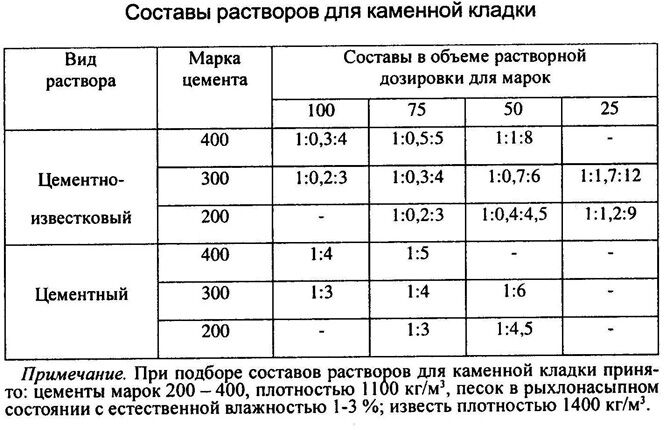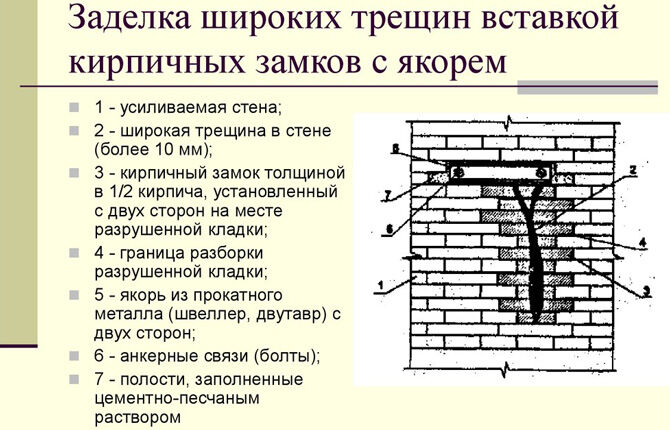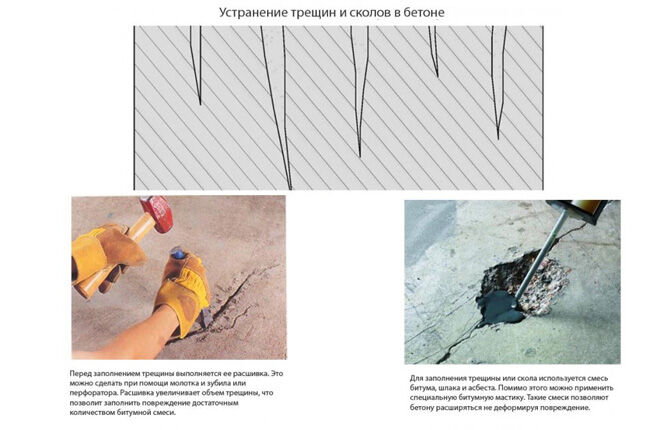How to properly repair a hole in a wall - tips and tricks from professionals
When dismantling old water pipes, anchors, or due to mechanical stress, a hole forms in the wall. To eliminate it, you do not need to call a construction team. The work can be carried out independently using standard tools. The restoration will be done by a person who has minimal experience in carrying out repairs. To figure out how to fill holes in the walls of an apartment, you should take into account the material from which the house is built.
The content of the article:
Hole in a brick wall
Brickwork is resistant to mechanical stress. Walls of this type are assembled from individual elements. Therefore, only those that are damaged are replaced. After repair, the restored place will not be different.
Big
You can repair a hole in a brick wall with your own hands. To do this, you will need to prepare a cement-sand mixture. More often, solutions with a cement to sand ratio of 1:3 are used.
To obtain a homogeneous composition in a short time, kneading is carried out with a construction mixer. You can repair a large hole in a brick wall in the following order:
- Clean the damaged area from finishing materials. If the hole is in a wall lined with brick, then no preparation is required. Finishing materials are removed so as to gain free access to the masonry joints.
- Remove the hardened mortar that fixes the damaged bricks. To make the cement mixture easier to clean, holes are drilled in the seams.In this case, a concrete drill, hammer drill or electric impact drill is used. The remaining solution is removed with a thin, sharp object. A screwdriver or chisel will do.
- Remove damaged elements. If the bricks are firmly fixed, they are broken with a hammer.
- Prepare the installation site. The bricks are cleaned of the hardened mixture. Dust and dirt are removed with air under pressure.
- Apply primer to the masonry surface. It improves surface adhesion. Preference is given to liquids with antifungal properties. It is applied with a spray gun, paint brush or roller.
- Fill the hole with new bricks. Use a pre-prepared cement-sand mortar.
The next step is to apply the finish. The installation method depends on the type of material used. For better adhesion, the brick wall is treated with primer.
Small
A small hole in the brick is sealed with a cement-sand mixture. The damaged area is pre-prepared for repair. This is necessary in order to ensure the best adhesion of the repair composition to the brick.
Minor damage is difficult to repair. To make it easier to fill the cavity with solution, it is expanded. Use a hammer drill or electric impact drill with concrete drills. The diameter of the replacement elements is selected taking into account the overall parameters of the hole.
The damaged area is drilled out. Broken elements and dust are cleaned off. For better adhesion, the brick is moistened with water. This way the moisture will leave the cement mortar gradually. This will improve its strength characteristics.
The consistency of the mixture should be thick. The ingredients are mixed gradually adding to the water. A thick, elastic composition is well suited for the job.It is securely held on the damaged area until completely dry.
A small hole in a brick wall is repaired by spreading mortar with a spatula. Simply attaching it to the wall will not work. When thrown, the composition hits the surface and fills small cavities. Before complete drying, level the restored area with a spatula or plaster trowel.
For finishing sanding, use a trowel with sandpaper installed. To speed up the work, electrically driven grinding machines are used. This is how the restored area is leveled in a short time.
How to repair a hole in drywall on a wall
A distinctive feature of drywall is its fragility. Mechanical impact of a small force leads to damage. You can repair the area yourself. No specialized equipment is used for this.
The work is carried out using a standard set of tools designed for installing drywall. To restore the integrity of a surface with minor damage, gypsum putty is used.
Big
For large through holes, you will need a piece of sheet of the same thickness. The dimensions of the piece are selected so that its overall parameters exceed the diameter of the hole formed on the wall.
The damaged area is repaired in the following order:
- Remove trim. Clear the wall next to the hole. Work is carried out carefully so as not to damage the sheet.
- Clean the area from damaged elements. All poorly fixed parts are removed from the drywall.
- Apply markings to the sheet. A rectangle is drawn outside the hole. Its sides must be located at a distance of at least 10 mm from the edge of the hole.The markings are applied with a pencil or marker.
- The material is cut along a pre-designated contour. A stationery knife is used for cutting. You can use a specialized saw designed for cuttings sheets of drywall.
- Remove dust and small abrasive particles. The debris is swept away with a hard-bristled brush.
- Prepare several pieces of metal profile or wooden blocks. Their length is chosen taking into account the dimensions of the cut hole. To seal a hole in a plasterboard wall, select blocks of dry wood. Wet parts will change shape as they dry. This will damage the drywall.
- The bars are laid on the inside and screwed to the sheet. After installation, a lathing is obtained for attaching a pre-prepared piece.
- Adjust the dimensions of the drywall section to fit the resulting rectangle. For ease of installation, the length and width of the section should be 2-3 mm less than the hole. After installation, the seam can be sealed with gypsum putty.
- Install the cut part and press it to the sheathing with fasteners.
- Mix gypsum putty. To speed up the work, use a construction mixer or an attachment to an electric drill. The putty is mixed with water to a homogeneous consistency.
- Cover the area to be restored. First of all, you need to seal the seams. To increase the degree of strength, after applying the first layer, a reinforcing mesh is applied to the joints. It is covered with gypsum putty on top.
- Sand the surface. For work, use a trowel with an installed abrasive mesh.
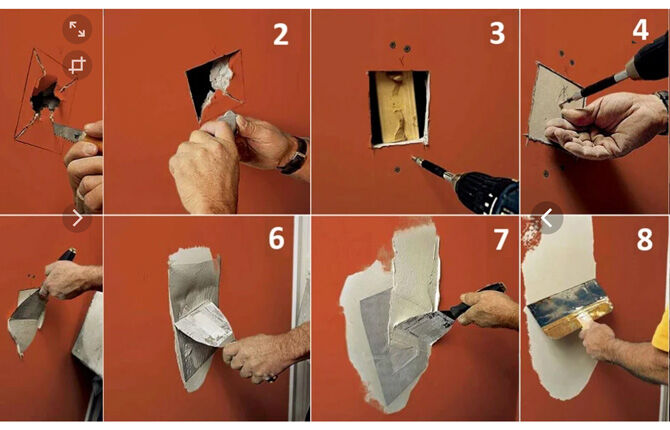
After restoration, finishing materials are installed on the damaged area.If painting is necessary, a coat of finishing compound should be applied.
Small
A small diameter hole in a plasterboard wall is sealed by applying putty. To work, you will need two types of gypsum composition - starting and finishing.
The first includes larger filler particles. It adheres well to the surface being treated. The finishing one has a fine filler and is used to prepare the wall for finishing.
To repair a small hole in the wall, remove the damaged parts. To increase the degree of adhesion, dirt is removed. They are swept away with air or a dry cloth.
During operation, a large amount of dust is generated. To eliminate the possibility of harm to health, you should use a respirator.
Prime the damaged area. Select a liquid that has deep penetrating properties. This improves the adhesion of surfaces and protects the wall from the formation of fungus. The primer is applied with a sprayer or roller.
Place on prepared drywall putty. You can fill a deep hole with several layers. If you apply a large amount of repair compound at the same time, it will not stick. To strengthen the structure, a reinforcing mesh is placed between the layers.
The hardened repair composition is subjected to grinding. This makes it possible to create a smooth surface. After restoration, finishing materials are installed.
Concrete wall
Surfaces made of concrete are durable. Holes appear when dismantling plumbing, heating, etc. Small indentations appear during impacts of varying strength. You can seal the holes yourself.
When working, use cement-sand mortar or putty.To figure out what mixture to fill holes in the wall with, take into account their overall parameters. For major damage, cement mortar will be required. Small depressions can be filled with putty.
Big
One-time application of concrete in large portions is impossible without preliminary preparation of the wall. It is necessary to manufacture a reinforcing grid. To seal a large hole in the wall, you need:
- Clear the hole of loose elements. Cracked parts are cleaned with a screwdriver or chisel. Contaminants are removed with a brush or air under pressure.
- Apply primer. They moisten the places that will come into contact with the solution. When selecting soil, its characteristics are taken into account. The liquid must be suitable for treating concrete surfaces.
- Drill holes in the wall. They are necessary for installing the reinforcing layer. The diameter of the drill is selected taking into account the size of the metal rods intended for making the grating. The parts must fit tightly into the holes.
- Install metal rods on the seats. The parts are welded together. This improves the rigidity of the structure. Any type of welding is suitable for connection.
- Make a lathing to prevent the solution from leaking out. Formwork is made from boards. The lathing is fixed to the wall with threaded fasteners.
- Mix the solution. The composition is kneaded until a homogeneous consistency is obtained.
- Fix a hole in a concrete wall by pouring mortar into the hole. The formwork will hold the composition until it hardens.
- Remove the sheathing until completely dry. Clean off the solution that has not completely hardened with a spatula. This way the surface is leveled, removing protrusions.
- The final stage is sanding the repaired area.
Finishing materials are applied to the restored wall. To improve adhesive properties, the surface is primed.
Small
You can fill a hole in a concrete wall with cement mortar or putty. In order for the applied composition to adhere firmly to the surface, it must be prepared.
Small holes and damage are cleaned from poorly fixed elements. They are pryed with a sharp object and removed. To make it easier to fill the cavities, they are expanded. Use a hammer drill or impact drill.
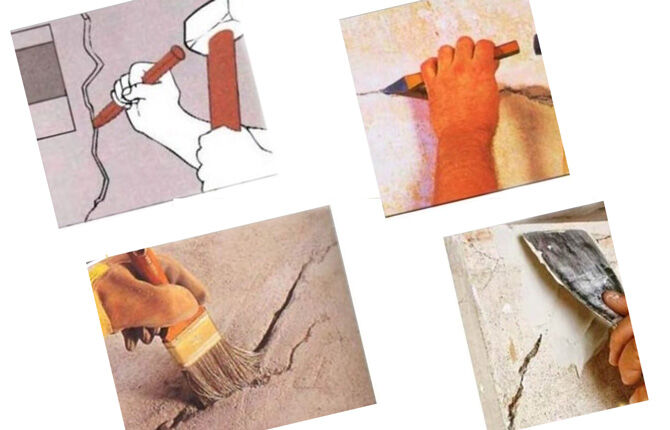
Before filling the hole, the prepared surface is cleaned of dirt. They are removed with a hard bristle brush or blown off with air under pressure.
To ensure gradual drying of the solution, the concrete wall is moistened with water. This way the moisture will remain in the repair composition until it hardens completely.
The solution is applied with a plaster trowel. The mixture must be thrown with force. This way you can fill the voids. This will increase the strength of the resulting surface.
The hardened repair composition is leveled at the same level with adjacent surfaces. Sanding is carried out with fine-grain sandpaper. To speed up the process, use a grinding machine.
How to repair a crack in a wall
The appearance of cracks requires repair work. If the damage is not corrected at the initial stage, it will lead to more serious damage. To figure out how to repair a crack in a wall, you need to pay attention to the material from which it is made.
Repairing cracks in brick walls
Two types of cracks occur on brick surfaces. Some appear in masonry joints. In this case, the bricks are not damaged.Others lead to disruption of the integrity of masonry elements.
To seal the crack, a cement composition is used. It is made independently. For mixing you will need 1 part cement and 3 parts sifted sand. Add water to the resulting dry mixture and knead until a homogeneous consistency is obtained.
To ensure the strength of the structure, a reinforcing layer of metal rods is mounted on the wall. To do this, cuts are made across the crack. Brick sawing is carried out using an angle grinder with a concrete disc. Holes are drilled along the edges of the slots. The diameter of the drill is selected taking into account the thickness of the rods.
The edges of the metal blanks are bent at right angles. The resulting parts are in the form of a bracket. They are driven into pre-drilled holes. This increases the strength of the structure and eliminates the possibility of further propagation of the crack.
The hole is filled with repair compound. To do this, use a rubber spatula. The solution is pressed into the crack. This technology allows you to fill the cavity as much as possible. The hardened composition is ground and finishing materials are applied.
In plasterboard walls
Cracks in walls occur due to mechanical stress. If damp wooden beams are used as sheathing, damage may occur when it dries out. It is preferable to seal this type of hole in the wall with a gypsum mixture. The work is carried out in the following order:
- Expand the site of damage. This is necessary for normal filling of the cavity. The crack is widened with a utility knife.
- Remove dirt. You can use compressed air, a hard bristle brush, or a vacuum cleaner.
- Apply primer. It improves adhesive properties and protects the slab from rotting.
- Apply the first layer of putty. Use a starting composition with large fraction filler.
- Lay the reinforcing mesh. It is pressed against the first layer.
- Apply the composition with fine filler.
- Wait until completely dry.
- Grind the restored area with an abrasive mesh.
After repair, the wall is ready for finishing. The installation method depends on the type of finishing material.
In concrete walls
You can repair a crack in a concrete wall with your own hands. The repair technology is no different from restoring brickwork.
Seal the crack in the wall with cement. It is pressed into the previously expanded cavity. If necessary, install a reinforcing layer of metal rods.
In some cases, you can seal a hole in the wall with foam. The material has a low degree of thermal conductivity. The hole is expanded with an angle grinder and cleaned of dirt. The foam is applied using a mounting gun. In this case, the cavity is not completely filled. This is necessary to expand the foam.
You can repair a hole in the wall with your own hands. Before starting work, take into account what material it is made of. To increase the strength of the structure, a reinforcing layer is used. This approach makes the surface resistant to mechanical damage.
Have you ever had to fill a hole in a wall? What material did you work with? Share your experience in the comments. Repost the article and bookmark it so you can quickly return to it if necessary.
This is interesting! 10 best construction mixers: review, advantages and disadvantages, price.
We also recommend watching a video that will reinforce your knowledge and answer any remaining questions.
How to cover a groove or hole in one go? How to prevent the plaster from retracting?
